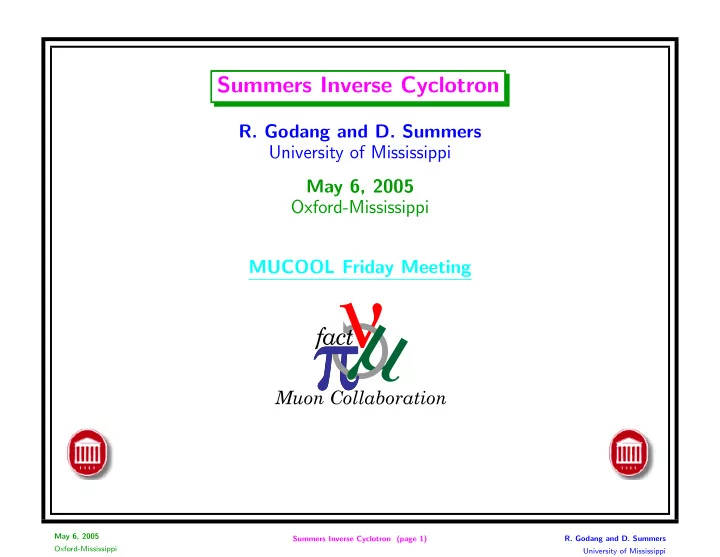

Summers Inverse Cyclotron R. Godang and D. Summers University of Mississippi May 6, 2005 Oxford-Mississippi MUCOOL Friday Meeting May 6, 2005 R. Godang and D. Summers Summers Inverse Cyclotron (page 1) Oxford-Mississippi University of Mississippi
Introduction � We are using Kirk and Garren’s Ring with Palmer’s sinusoidal field • Radius of reference orbit is 63.7037 cm • Each cell is 1.00065 m long with 45 degrees • Whole ring filled with high pressure H2 gas • Fine wedges with smooth grade density � Ring and wedges geometry (R. Palmer): May 6, 2005 R. Godang and D. Summers Summers Inverse Cyclotron (page 2) Oxford-Mississippi University of Mississippi
ICOOL in LINUX � We have installed ICOOL 2.85 in LINUX at Mississippi • Change all ext from *.for to *.f • Convert the files from windows to linux (dos2unix) • Include appropriate files: iunix.f, iunixc.c and gmake • Recompile all code in Linux and test it • It works fine so far! � We injected 3 tracks (muon) with momentum: • 157 MeV/c (- 9% dp/p) • 172 MeV/c (nominal value) • 187 MeV/c (+ 9% dp/p) � Let energy loss, dE/dx, naturally inject the particles scattering and straggling process are off at the moment May 6, 2005 R. Godang and D. Summers Summers Inverse Cyclotron (page 3) Oxford-Mississippi University of Mississippi
100 Atm H2 Gas : X Vs Z 0 0 -20 -20 -40 -40 X (cm) 0 25 50 0 25 50 0 0 -20 -20 -40 -40 0 25 50 0 25 50 Z (meter) Order : All tracks, 157 MeV/c, 172 MeV/c, and 187 MeV/c (red) May 6, 2005 R. Godang and D. Summers Summers Inverse Cyclotron (page 4) Oxford-Mississippi University of Mississippi
Three Tracks Injection (Palmer) Order : 157 MeV/c, 172 MeV/c, and 187 MeV/c May 6, 2005 R. Godang and D. Summers Summers Inverse Cyclotron (page 5) Oxford-Mississippi University of Mississippi
Coordinate Transformation � ICOOL uses Frenet-Serret Coordinates � NBT = Nominal Beam Trajectory • X = horizontal distance from NBT • Y = vertical distance from NBT • Z = a distance from starting point along NBT May 6, 2005 R. Godang and D. Summers Summers Inverse Cyclotron (page 6) Oxford-Mississippi University of Mississippi
MUON Capture Solution � Slow Negative Muon Capture Solution, when muons stop in the center � Surface Muon Beams use Positive Muons � Negative Muons are Captured by Nuclei � Use Muon Catalyzed Fusion to free Negative Muons that may be Captured � Probability that a muon will stick to newly formed He nucleus (Panomarev, Contemporary Physics, 31, 219, 1990) • D D mu → 0.12 • D T mu → 0.0043 � In a Deuterium-Tritium Mixture a D T mu molecule is rapidly formed, regardless of how the muon is first captured � The 12% D D mu sticking factor might be enough Only Deuterium would be used; no radioactive Tritium � Gas Pressure ∼ 1/1000 Atmosphere May 6, 2005 R. Godang and D. Summers Summers Inverse Cyclotron (page 7) Oxford-Mississippi University of Mississippi
Recommend
More recommend